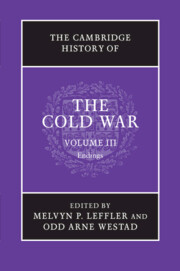Book contents
- Frontmatter
- 1 The Cold War and the intellectual history of the late twentieth century
- 2 The world economy and the Cold War, 1970–1990
- 3 The rise and fall of Eurocommunism
- 4 The Cold War and Jimmy Carter
- 5 Soviet foreign policy from détente to Gorbachev, 1975–1985
- 6 Islamism, the Iranian revolution, and the Soviet invasion of Afghanistan
- 7 The collapse of superpower détente, 1975–1980
- 8 Japan and the Cold War, 1960–1991
- 9 China and the Cold War after Mao
- 10 The Cold War in Central America, 1975–1991
- 11 The Cold War and southern Africa, 1976–1990
- 12 The Gorbachev revolution and the end of the Cold War
- 13 US foreign policy under Reagan and Bush
- 14 Western Europe and the end of the Cold War, 1979–1989
- 15 The East European revolutions of 1989
- 16 The unification of Germany, 1985–1991
- 17 The collapse of the Soviet Union, 1990–1991
- 18 Science, technology, and the Cold War
- 19 Transnational organizations and the Cold War
- 20 The biosphere and the Cold War
- 21 The Cold War and human rights
- 22 The Cold War in the longue durée: global migration, public health, and population control
- 23 Consumer capitalism and the end of the Cold War
- 24 An ‘incredibly swift transition’: reflections on the end of the Cold War
- 25 The restructuring of the international system after the Cold War
- Bibliographical essay
- Index
- References
15 - The East European revolutions of 1989
Published online by Cambridge University Press: 28 September 2010
- Frontmatter
- 1 The Cold War and the intellectual history of the late twentieth century
- 2 The world economy and the Cold War, 1970–1990
- 3 The rise and fall of Eurocommunism
- 4 The Cold War and Jimmy Carter
- 5 Soviet foreign policy from détente to Gorbachev, 1975–1985
- 6 Islamism, the Iranian revolution, and the Soviet invasion of Afghanistan
- 7 The collapse of superpower détente, 1975–1980
- 8 Japan and the Cold War, 1960–1991
- 9 China and the Cold War after Mao
- 10 The Cold War in Central America, 1975–1991
- 11 The Cold War and southern Africa, 1976–1990
- 12 The Gorbachev revolution and the end of the Cold War
- 13 US foreign policy under Reagan and Bush
- 14 Western Europe and the end of the Cold War, 1979–1989
- 15 The East European revolutions of 1989
- 16 The unification of Germany, 1985–1991
- 17 The collapse of the Soviet Union, 1990–1991
- 18 Science, technology, and the Cold War
- 19 Transnational organizations and the Cold War
- 20 The biosphere and the Cold War
- 21 The Cold War and human rights
- 22 The Cold War in the longue durée: global migration, public health, and population control
- 23 Consumer capitalism and the end of the Cold War
- 24 An ‘incredibly swift transition’: reflections on the end of the Cold War
- 25 The restructuring of the international system after the Cold War
- Bibliographical essay
- Index
- References
Summary
Soviet acceptance of the collapse of East European Communist regimes in 1989 must be considered the single most significant event leading to the end of the Cold War. It provided the most compelling evidence of the magnitude of changes that were going on inside the USSR in 1989. Until then, the importance of Mikhail Gorbachev’s reforms was doubted in many places. Soviet behavior in 1989 in Eastern Europe was the definitive reality check of the “new thinking” in Soviet foreign policy.
Provocative as it may sound, it is not so much what happened in Eastern Europe itself in 1989 that was historically significant. The fragility of the Communist regimes there had been on the historical record for many years. It was Soviet tolerance for change that made the difference. Until Gorbachev’s reforms, Soviet domination of Eastern Europe had been internalized both in the East and in the West as an inescapable fact until some indeterminate future time. That is why the complete emancipation of Eastern Europe in 1989, while Soviet power was still intact, came as a breathtaking surprise in the West, in Eastern Europe itself, and even in the Soviet Union. The central argument of this chapter is that, while each revolution had specific national characteristics, their pace and scale were largely shaped by the gradual discovery of the scope of Soviet tolerance.
- Type
- Chapter
- Information
- The Cambridge History of the Cold War , pp. 311 - 332Publisher: Cambridge University PressPrint publication year: 2010
References
- 2
- Cited by

